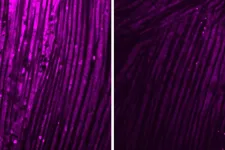(Press-News.org) Systems designed to treat arsenic in private well water may be malfunctioning and endangering the health of people who count on them to keep their water safe, according to Rutgers researchers.
Megan Rockafellow-Baldoni, an assistant professor of environmental and occupational health and justice at the Rutgers School of Public Health, together with co-authors including Rutgers alum Steven Spayd, a retired research scientist formerly with the New Jersey Department of Environmental Protection, tested the water of 62 New Jersey homes with whole-house arsenic-removing water treatment systems. Their study was published in the journal Water Environment Research.
Spayd said "these water treatment systems may be solving one exposure problem by removing dissolved arsenic from the water, but potentially creating a new exposure, the ingestion of arsenic treatment media with high concentrations of arsenic.”
While arsenic is a naturally occurring element, it is a known human carcinogen and dangerous to human health. For this reason, when New Jersey homes with wells are sold, it is required they are tested for arsenic. If the element is found above safe levels for drinking water, an arsenic treatment system can be installed.
In such treatment systems, water from the well flows through a specialized adsorptive filter. When the system functions as intended, the adsorptive media and the filtered arsenic are left behind in the treatment tank while potable water flows into the home.
However, Rockafellow-Baldoni and co-authors of the study found microparticles of arsenic treatment media in the drinking water at 71 percent of the tested homes. This media is intended to remain within the treatment tank and never enter a home’s drinking water as it likely contains high concentrations of adsorbed arsenic.
Arsenic may not be the only contaminant of concern: When radium, another naturally occurring yet hazardous substance, is detected in well water, it is effectively removed with a water softener.
Through the course of their research, Rockafellow-Baldoni and Spayd detected microparticles of water softener resin in 84 percent of the homes with water softeners, suggesting that in some homes, microparticles with adsorbed radium might also be present.
They added that further research is needed to determine the reason for malfunction and determine the arsenic and radium concentrations in the escaping media.
Until the problem can be further studied and resolved, the researchers encourage well owners install a 5-micron post-treatment sediment filter to capture escaping media. Information about obtaining and properly installing the filter is available from the New Jersey Geological and Water Survey.
END
Rutgers researchers spot potential hazard with private well water treatment
Microparticles of arsenic treatment media and water softener resin are detected in drinking water
2024-07-12
ELSE PRESS RELEASES FROM THIS DATE:
When to trust an AI model
2024-07-12
CAMBRIDGE, MA – Because machine-learning models can give false predictions, researchers often equip them with the ability to tell a user how confident they are about a certain decision. This is especially important in high-stake settings, such as when models are used to help identify disease in medical images or filter job applications.
But a model’s uncertainty quantifications are only useful if they are accurate. If a model says it is 49% confident that a medical image shows a pleural effusion, then 49% of the time, the model should be right.
MIT ...
Research shows gamified investment sites have risks for novice investors
2024-07-12
TORONTO - What happens when online investment trading platforms start to resemble games that keep people playing for hours, with badges and exploding confetti to reward investors for their engagement?
For those who know what they’re doing, it won’t make much of a difference. New research from the University of Toronto engaging nearly 1,000 volunteers in artificial investment scenarios shows that more informational features such as price change notifications might even help savvy investors execute ...
Specially equipped natural killer cells show effectiveness against the most common form of ovarian cancer
2024-07-12
RESEARCH SUMMARY
Study Title: CAR memory-like NK cells targeting the membrane proximal domain of mesothelin demonstrate promising activity in ovarian cancer
Publication: Science Advances
Dana-Farber Cancer Institute authors include: Rizwan Romee, MD, senior author; and Mubin Tarannum, PhD, KhanhLinh Dinh, and Juliana Vergara, MD, MMSc, co-first authors
Summary: Natural killer, or NK, cells endowed with memory-like abilities and armed with a novel chimeric antigen receptor (CAR) have generated encouraging results in experiments in epithelial ovarian cancer ...
Entering the golden age for antibody-drug conjugates in gynecologic cancer
2024-07-12
“We are optimistic that the incorporation of ADCs into the treatment of aggressive tumors and treatment refractory gynecologic cancers will improve quality of life and survival outcomes in our patients.”
BUFFALO, NY- July 12, 2024 – A new editorial paper was published in Oncoscience (Volume 11) on May 20, 2024, entitled, “Entering the golden age for antibody-drug conjugates in gynecologic cancer.”
In this new editorial, researchers Michelle Greenman, Blair McNamara, Levent Mutlu, and Alessandro D. Santin from Yale University School of Medicine discuss gynecologic cancers. Biologically aggressive ...
Judge: Texas university must release records on research study that resulted in deaths of dozens of animals
2024-07-12
SAN ANGELO, Texas —Tom Green County District Court Judge Barbara L. Walther ruled Thursday, July 11, 2024, that Angelo State University must release public records relating to an experiment conducted on dozens of mice that resulted in the animals’ unnecessary suffering and death, reportedly to study the impact of the foster care system on human children.
The ruling overturns Texas Attorney General Ken Paxton’s Nov. 17, 2022 decision to side with the university in denying the records.
On July 13, 2023, the Physicians Committee for Responsible Medicine, a Washington, D.C. based health advocacy group of more than 17,000 doctor members that encourages higher standards ...
UMass Amherst food scientist rises to the challenge of giving marbled fatty feel and taste to plant-based meat
2024-07-12
One of the challenges of creating realistic-looking and delectable plant-based meat is mimicking the marbled effect of animal fat that many carnivores expect and enjoy.
A University of Massachusetts Amherst food scientist has a plan to tackle this quandary by developing new technology supported by a $250,000 grant from the Good Food Institute. The not-for-profit think tank promotes plant-based alternatives to meat, dairy and eggs, as well as cultivated “clean meat” grown from animal cells in a facility.
The technology proposed ...
Complex impact of large wildfires on ozone layer dynamics unveiled by new study
2024-07-12
In a revelation that highlights the fragile balance of our planet's atmosphere, scientists from China, Germany, and the USA have uncovered an unexpected link between massive wildfire events and the chemistry of the ozone layer. Published in Science Advances, this study reveals how wildfires, such as the catastrophic 2019/20 Australian bushfires, impact the stratosphere in previously unseen ways.
The ozone layer, a crucial shield protecting life on Earth from harmful ultraviolet (UV) radiation, has been on a path to ...
Brain inflammation triggers muscle weakness after infections
2024-07-12
Infections and neurodegenerative diseases cause inflammation in the brain. But for unknown reasons, patients with brain inflammation often develop muscle problems that seem to be independent of the central nervous system. Now, researchers at Washington University School of Medicine in St. Louis have revealed how brain inflammation releases a specific protein that travels from the brain to the muscles and causes a loss of muscle function.
The study, in fruit flies and mice, also identified ways to block this process, which could have ...
Research alert: All stem cell therapies are not created equal
2024-07-12
Researchers from University of California San Diego have found that two of the most frequently administered stem cell therapies, which are often used interchangeably, actually contain completely different types of cells. The results challenge the current “one-cell-cures-all” paradigm in orthopedic stem cell therapeutics and highlight the need for more informed and rigorous characterization of injectable stem cell therapies before they are marketed for use in patients.
The researchers analyzed cell populations of autologous bone marrow aspirate concentrate (BMAC) and adipose-derived ...
Complex impact of large wildfires on ozone layer dynamics
2024-07-12
The ozone layer, a crucial shield protecting life on Earth from harmful ultraviolet (UV) radiation, has been on a path to recovery thanks to the Montreal Protocol. This landmark international treaty, adopted in 1987, successfully led to phasing out the production of numerous substances responsible for ozone depletion. Over the past decades, the ozone layer has shown significant signs of healing, a testament to global cooperation and environmental policy.
However, the stability of this vital atmospheric layer is now facing a new and unexpected challenge. During the 2019/20 Australian wildfires, ...
LAST 30 PRESS RELEASES:
Post-stroke injection protects the brain in preclinical study
Cardiovascular risk score predicts multiple eye diseases
Health: estimated one in ten British adults used or interested in GLP-1 medications for weight loss
Exercise to treat depression yields similar results to therapy
Whooping cough vaccination for pregnant women strengthens babies’ immune system
Dramatic decline in new cases of orphanhood in Uganda driven by HIV treatment and prevention programs
Stopping weight loss drugs linked to weight regain and reversal of heart health markers
Higher intake of food preservatives linked to increased cancer risk
Mass General Brigham–developed cholera vaccine completes phase 1 trial
First experimental validation of a “150-year-old chemical common sense” direct visualization of the molecular structural changes in the ultrafast anthracene [4+4] photocycloaddition reaction
Lack of support for people on weight loss drugs leaves them vulnerable to nutritional deficiencies, say experts
Dogs’ dinners can have greater climate impact than owners’
Are you ready to swap salmon for sprats and sardines?
1.6 million UK adults used weight loss drugs in past year
American College of Cardiology comments on new dietary guidelines for Americans
American Society of Gene & Cell Therapy and Orphan Therapeutics Accelerator partner to advance and commercialize promising rare disease treatments
One in 14 patients having day case surgery have new or worse chronic pain 3 months after their operation
New study highlights link between eviction rates and gun violence
Heatwaves heat up soil but not toxin levels in rice, study finds
Digital modeling reveals where construction carbon emissions really come from
Turning farm waste into water filters
New study shows how the spleen helps the immune system accept a transplant
New Mayo Clinic study advances personalized prostate cancer education with an EHR-integrated AI agent
Researchers identify novel therapeutic target to improve recovery after nerve injury
Microbes in breast milk help populate infant gut microbiomes
Reprogramming immunity to rewrite the story of Type 1 diabetes
New tool narrows the search for ideal material structures
Artificial saliva containing sugarcane protein helps protect the teeth of patients with head and neck cancer
Understanding the role of linear ubiquitination in T-tubule biogenesis
Researchers identify urban atmosphere as primary reservoir of microplastics
[Press-News.org] Rutgers researchers spot potential hazard with private well water treatmentMicroparticles of arsenic treatment media and water softener resin are detected in drinking water


